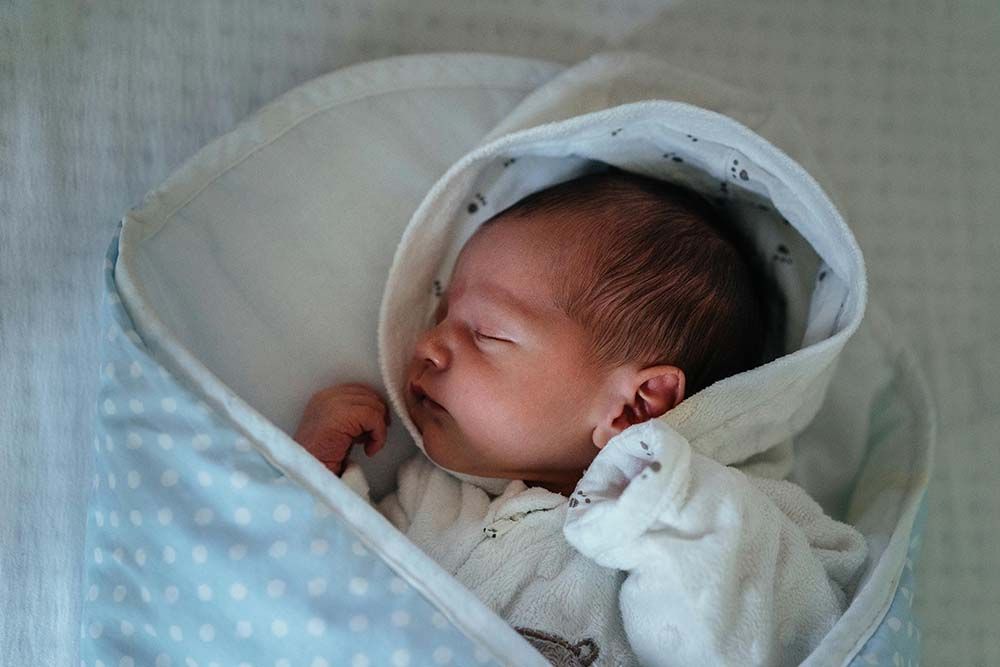

Sleep is not only vital for baby's development, but also help regulate personal mood. In fact, sleep is a major challenge for most parents because their babies can frequently and irregularly wake up at night or have trouble in falling asleep. Thus, it is necessary to sleep train your baby to improve sleep quality. In this article, we'll provide you with useful sleep training baby methods, tips and related issues, helping your baby form a healthy and sustainable sleep habit.
Moonycare App is your powerful helper in the training process!
If you are doing sleep training for your baby, Moonycare will be your right-hand tool. It is an intelligent baby recording app designed specifically for parents, which can easily track your baby's sleep, feeding, defecation and other activities. With Moonycare, you can accurately record the time your baby falls asleep and wakes up each time, providing data support for you to develop a more personalized sleep training plan. Through accurate data tracking, you can better understand your baby's sleep changes, develop a suitable sleep training plan, and help your baby adapt to a regular schedule faster and enter a healthy sleep pattern.
IN THIS ARTICLE
What is the best age to sleep train your baby?
How long will it usually take?
6 effective methods available for you
Frequently asked related questions
What is Baby Sleep Training?
Sleep training is to train your baby to fall asleep independently without being rocked, cuddled, fed, shushed or any help from the third-party caregivers. What's more, by doing it, babies can even start to master self-soothing and get back to sleep if they suddenly wake up at night. This way largely improves the overall sleep quality of the family, returning restful sleeps to fatigue parents.
When to Sleep Train Baby?
Generally speaking, it is never too late to start sleep training for babies at any age. But it is not recommended to start too early, because babies haven't developed a mature sleep pattern to recognize circadian rhythm.
From the perspective of parenting experts, they suggest that the best age to start sleep training is around 4 to 6 months old. At this time, babies are old enough to take a 6-8 hour uninterrupted sleep at night, and are suitable to start learning to comfort themselves without night feeding. More importantly, babies at 4 months haven't grow consciousness to associate the provided comforts (feeding, rocking, etc.) with sleep.
How Long Does Sleep Training Take?
Different methods require different amounts of time, coupled with the uniqueness of each baby, it is hard to estimate the exact amount of time needed. However, normally, taking about 1 week will contribute a little to sleep. While some methods are useful and some are not, the consistency of every parent or caregiver also matters a lot. If you haven't seen any improvement after trying the method for over 2 weeks, you can consider altering to another training method or turning to seek help from your pediatrician.
6 Effective Baby Sleep Training Methods for your Choice
1. Ferber Method (Gradual Extinction)
-
Description: Keep the same routine before bedtime, put baby to bed if they are sleepy, slightly soothe your baby, then leave the room and close the door. If your baby crying, don't rush to comfort instantly. Instead, gradually increasing the amount of time you wait before responding to your baby's cries.
-
How to sleep train a baby:
-
Start by waiting a short time(e.g., 2 minutes) before responding to your baby.
-
Increase the waiting time gradually each night, e.g., 5 minutes, 10 minutes, and so on.
-
Gradually reduce the frequency of checks and increase the intervals until the baby can fall asleep independently.
-
Advantages:
-
Gradual approach reduces stress for both baby and parents.
-
Relatively quick results compared to other gentle methods.
-
Disadvantages:
-
Some crying is involved, which can be emotionally challenging for parents.
-
May not work for all babies or families.
2. Cry-It-Out (CIO)
-
Description: Make sure that your baby is well fed before bedtime. Gently put him/her to bed if the bedtime is approaching, and leave the room. Make no response to any cries, as long as your baby is safe. Your baby may cry at the beginning but will ultimately become exhausted and fall asleep.
-
How to sleep train a baby:
-
Feed your baby and put them to a comfortable and safe environment.
-
Leave the room, allow your baby to fall asleep independently.
-
But keep an eye on your baby's condition from the outdoor. Gradually increase the time between checks until your baby falls asleep.
-
Advantages:
-
Can lead to quick results.
-
Disadvantages:
-
Significant crying can be stressful for both baby and parents.
-
May not be suitable for all families due to emotional concerns.
3. Chair Method
-
Description: Sitting in a chair near your baby's crib until they fall asleep, then gradually moving farther away.
-
How to sleep train a baby:
-
Sit in a chair next to the crib and let your baby fall asleep.
-
After they fall asleep, leave the room and come back to sit if your baby is crying. Over several nights, move the chair a bit farther away each time.
-
Eventually, you can leave the room, and your baby will learn to fall asleep independently.
-
Advantages:
-
Gradual approach that reduces stress for both baby and parents.
-
Maintains a physical presence near the baby, which can be reassuring.
-
Disadvantages:
-
Can take longer to see results compared to more direct methods.
-
Requires patience and consistency.
4. Positive Reinforcement
-
Description: Using praise, rewards, and encouragement to reinforce good sleep behaviors.
-
How to sleep train a baby:
-
Praise your baby for settling down quickly or staying asleep.
-
Use small rewards for restful nights, like extra cuddles.
-
Gradually reduce the need for rewards as your baby develops better sleep habits.
-
Advantages:
-
Positive approach that reinforces good behavior.
-
Build a strong bond between parent and baby.
-
Disadvantages:
-
Can take longer to work.
-
May require creative reward systems.
5. Pick-Up/Put-Down Method
-
Description: If your baby cries when they are going to sleep, pick them up, comfort them and put them back down to sleep. And repeating this process until your baby is completely asleep.
-
How to sleep train a baby:
-
Pick up your baby when they cry.
-
Hold and soothe them until they calm down.
-
Place them back in the crib while still awake.
-
Repeat the process until your baby falls asleep.
-
Advantages:
-
Provides physical comfort and reassurance.
-
Build an intimate bond between babies and parents.
-
Disadvantages:
-
Can be time-consuming and physically demanding.
-
Can cause fatigue and annoyance to the caregivers.
6. Fading Method
-
Description: As baby falls asleep, parents gradually reduce the amount of contact or assistance with baby. By doing so, it helps your baby fall asleep on their own.
-
How to sleep train a baby:
-
Start by sitting next to your baby and holding their hand.
-
Gradually move farther away from the crib or bed each night.
-
Reduce the amount of physical contact until your baby can fall asleep independently.
-
Advantages:
-
A gentle method can avoid unnecessary crying.
-
Cause less stress.
-
Disadvantages:
-
Cannot work in a short time.
-
Requires patience and consistency.
As you can see, each method has its own pros and cons. What works for some babies may not work for others, thus, the key is to put these methods into practice and choose the one that makes your baby and you feel comfortable and sustainable. When making your decision, you should take your baby's temperament, your personal parenting preferences and your family's values into considerations. If you have any questions at this process, you can also consult with a pediatrician for professional guidance.
6 Useful Tips to Promote Sleep Training Baby
-
Establish a gentle routine before bedtime. It is necessary to develop a range of regular activities before bedtime, because new babies don't have concept of time. Once the sleep habits are formed, babies will recognize that it is time to sleep. Nevertheless, remember the included activities must be calm, such as a warm bath, gentle reading, and feeding. Otherwise, those exciting events can lead to overtiredness, making babies hard to fall asleep.
-
Put baby to bed while drowsy. The purpose of sleep training is to teach babies to live an independent sleep habit without third party's soothing. So you need to put them down to their bed or crib when they are sleepy but awake, allowing them to learn to fall asleep on their own. Thus, you need pay attention to the sleepy cues of babies, such as yawning, rubbing eyes or becoming grumpy or crying.
-
Control your response. Babies may cry for suddenly wakening-up, or make various noises during sleeping. You are supposed to wait for a while to give your baby time to sooth themselves back to sleep. But if they fail to fall back to sleep, you can come to feed, change diapers or do any checks to comfort them. But you should be calm, quiet and quick without additional interactions, emphasizing to your baby that is sleep time instead of playtime.
-
Be patient and consistent. Patience and consistency are vital in sleep training, because the methods may not work quickly. You should create and follow a reasonable sleep schedule that includes according training methods, giving enough time for your baby to accommodate. What's more, if you go out for traveling with your baby, you should try to keep your training schedule and routine as many as possible.
-
Be flexible. When you train your little one, you should figure out which method is suitable for your baby and family. If the method doesn't work, you are ought to know when to transition to another method.
-
Check your baby's condition.Make sure that your baby is healthy and is under a comfortable condition or sleep environment. Eliminating the possible additional issues that may affect baby's sleep.
Frequently Asked Questions about Sleep Training Baby?
1. Is sleep training safe for your babies?
Yes. Although some methods can initially make babies discomfort and resistance, leading to cry, it won't bring actual mental or physical harm to babies. And there are substantial researches about baby sleep training that can support this view. On the contrary, an effective method will benefit both babies and the entire families, greatly improves sleep quality, enhancing mood and bringing overall health and well-being back to moms.
2. Does night weaning belong to sleep training baby?
No, they are totally two different things. Night weaning means that when your baby grows up to the proper age, reaching a stable gaining level in weight and growth curve, he or she will intake sufficient food at daytime and skip night feedings. However, when your baby is ready to reduce or completely give up night feedings, sleep training and night weaning can be started simultaneously for an uninterrupted sleep.
3. What situations is not suitable for starting sleep training?
-
Age is key: Wait until your baby reaches 4 months old, which is optimal age that the parental experts suggest. Start earlier can only be a waste of time.
-
Variable distractions: If your recent life is full of significant change or uncertainty, such as traveling, personnel changes, moving, etc., don't rush to begin the training, because these changes can disrupt the training routine and make it hard for your baby to adjust.
-
Baby's condition: Postpone sleep training if your baby is sick, experiencing discomfort from developmental milestones like teething, or dealing with other growth pains. You'd better wait and begin the training until your baby is feeling good.
-
Parental people's condition: If you and your family haven't fully prepared for training, then not to start it, because sleep training can be challenging for you with unexpected issues.
4. Is there any recommended sleep training books?
In addition to baby sleep training methods, some parents may also wonder baby sleep training books to learn more nursing knowledge systematically. Below we have collected top 5 currently best-selling books for your reference.
-
Healthy Sleep Habits, Happy Child (Author: Marc Weissbluth M.D.)
-
Secrets of the Baby Whisperer: How to Calm, Connect, and Communicate with Your Baby (Author: Tracy Hogg)
-
Twelve Hours' Sleep by Twelve Weeks Old: A Step-by-Step Plan for Baby Sleep Success (Author: Suzy Giordano, Lisa Abidin)
-
Sweet Sleep: Nighttime and Naptime Strategies for the Breastfeeding Family (Author: La Leche League International, Diane Wiessinger, Diana West, Linda J. Smith, Teresa Pitman)
-
Precious Little Sleep: The Complete Baby Sleep Guide for Modern Parents (Author: Alexis Dubief)
Last Words
After mastering baby sleep training related issues, you can start implementing sleep training baby based on individual demanding. But if you are unsure how much sleep is appropriate for your baby, you can refer to the average sleep duration for each age, 4 months, 8 months, 3 years, etc. However, since every baby is unique and has different sleep habits, it is acceptable if the total amount of time varies slightly as long as it can support baby's development.
























